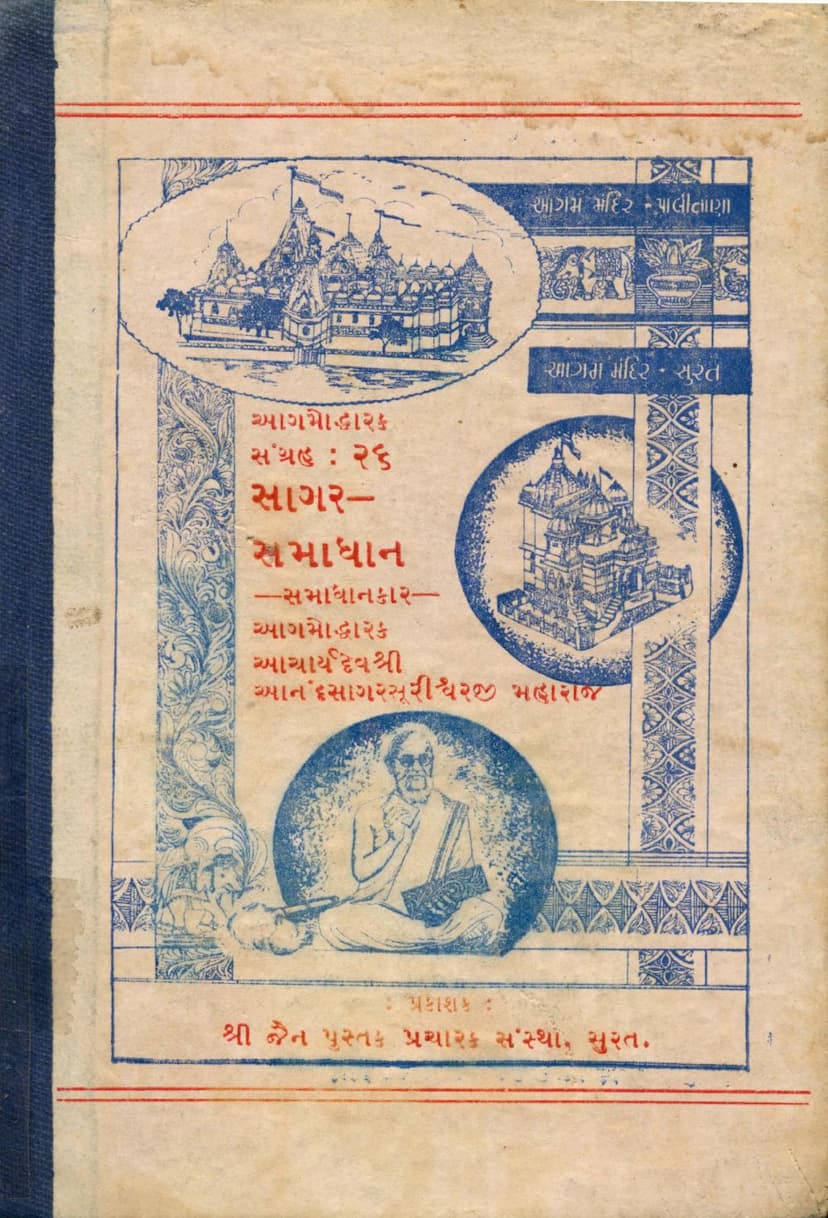Sagar Samadhan Part 02
Added to library: September 2, 2025

Summary
This is a summary of the Jain text "Sagar Samadhan Part 02" by Anandsagarsuri, published by Jain Pustak Pracharak Samstha. The text is a collection of answers to questions posed by the Chaturvidh Sangh (four-fold Jain community) to the esteemed Acharya Anand Sagarsurishwarji Maharaj.
The book is structured as a Q&A, addressing a wide range of topics within Jain philosophy, scriptures, practices, and history. The summary below is organized by major themes and key points discussed, based on the provided pages:
1. Spiritual Guidance and Principles:
- The Nature of the Soul and Moksha: The text delves into the soul's inherent nature, its connection to karma, and the path to liberation (moksha). It discusses how through right faith (Samyaktva), right knowledge (Samyak Gyan), and right conduct (Samyak Charitra), liberation is achieved.
- Paths to Liberation: Different types of liberation are discussed, emphasizing the importance of correct understanding of the soul's nature and the processes of karma.
- The Role of Tapa (Austerity): Various forms of austerity are explained, including their impact on karma and their role in spiritual progress. The text clarifies that austerity is not merely physical but involves mental and verbal control as well.
- The Importance of Samyaktva (Right Faith): The text repeatedly stresses that Samyaktva is crucial for spiritual progress. It explains that true Samyaktva leads to right conduct and right knowledge, which are essential for achieving liberation.
- Karma and its Effects: The complex nature of karma, its bondage, fruition, and cessation are explained. The text clarifies that while the soul's inherent nature is pure, karma acts as an obstruction.
2. Jain Scriptures and Practices:
- Interpretation of Scriptures: The book addresses various interpretations of Jain scriptures, clarifying apparent contradictions or nuances in verses from different Agamas and commentaries.
- The Significance of Rituals: The text explains the underlying philosophy and purpose behind various Jain rituals, such as Chaitra Vandana, Stotra, and other forms of worship. It distinguishes between the outward observance and the inner spiritual intent.
- The Role of Acharyas and Gurus: The importance of spiritual preceptors (Gurus) and their teachings is highlighted, emphasizing adherence to their guidance for spiritual growth.
- Understanding of Tithis (Lunar Days) and Festivals: A significant portion of the text is dedicated to clarifying the intricate rules and interpretations regarding the observance of Jain festivals and specific lunar days like Ashtami, Chaturdashi, Purnima, and Amavasya, especially concerning the concept of Tithi Kshaya (waning of a lunar day) and Vriddhi (waxing). It addresses how to correctly observe these days based on astronomical calculations and scriptural traditions, emphasizing the importance of adhering to established practices.
- The Nature of Vows (Anuvratas and Mahavratas): The text clarifies the meaning and application of various vows taken by laypeople and monks, explaining the nuances and scope of these commitments.
- Food and Dietary Rules: Discussions around permissible and impermissible foods, including the concepts of 'Sattivik' and 'Abhakshya' foods, are present.
3. Philosophical Debates and Clarifications:
- Nayas (Standpoints) and Syadvada: The text touches upon the Jain principle of Syadvada (the doctrine of manifold predication) and the importance of understanding different Nayas (standpoints) for a complete philosophical understanding.
- The Soul and its Nature: Discussions on the soul's attributes, its existence beyond physical form, and its journey through different lifetimes are explored.
- Debates on Specific Concepts: The book addresses various intellectual and philosophical debates within Jainism, offering clarifications on terms like 'Nigod', 'Vaikriya Sharir', 'Avadhijnana', and others.
- The Meaning of 'Samyak' in Gyan and Charitra: The text clarifies how 'Samyak' (right) applies to knowledge and conduct, distinguishing between mere intellectual understanding and true spiritual realization.
4. Historical and Biographical Information:
- The Legacy of Acharya Anand Sagarsurishwarji: The book honors Acharya Anand Sagarsurishwarji Maharaj, highlighting his contributions to Jain scriptures and his role in establishing important Jain temples and institutions, particularly in Surat.
- The Founding of Jain Pustak Pracharak Samstha: The publication of this book by the Samstha is mentioned, along with a list of other books published under the inspiration of Acharya Anand Sagarsurishwarji Maharaj.
- References to Historical Events and Figures: The text indirectly refers to historical events and the lives of various Jain figures to illustrate philosophical points or scriptural interpretations.
5. Resolution of Doubts and Misconceptions:
- Addressing Erroneous Beliefs: The text aims to clarify misunderstandings and provide accurate scriptural interpretations for common doubts that arise within the community.
- Emphasis on Scriptural Authority: The importance of relying on the original scriptures and the interpretations of learned Acharyas is consistently emphasized.
In essence, "Sagar Samadhan Part 02" serves as a comprehensive guide for Jain followers, providing answers to a vast array of spiritual, philosophical, and practical questions, all rooted in the profound teachings of Jainism and the wisdom of Acharya Anand Sagarsurishwarji Maharaj. The book's extensive table of contents (Vishayanukram) at the end indicates the breadth of topics covered, reflecting a commitment to detailed scriptural exposition.